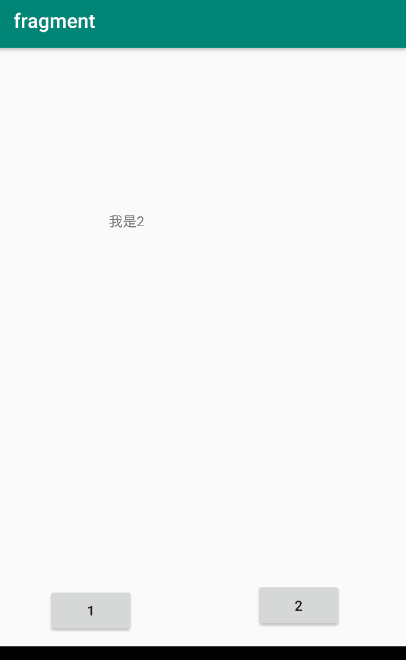首先是activity中的布局
<?xml version="1.0" encoding="utf-8"?>
<androidx.constraintlayout.widget.ConstraintLayout xmlns:android="http://schemas.android.com/apk/res/android"
xmlns:app="http://schemas.android.com/apk/res-auto"
xmlns:tools="http://schemas.android.com/tools"
android:layout_width="match_parent"
android:layout_height="match_parent"
tools:context=".MainActivity">
<FrameLayout
android:id="@+id/fragment"
android:layout_width="395dp"
android:layout_height="509dp"
app:layout_constraintEnd_toEndOf="parent"
app:layout_constraintHorizontal_bias="0.333"
app:layout_constraintStart_toStartOf="parent"
app:layout_constraintTop_toTopOf="parent">
</FrameLayout>
<Button
android:id="@+id/b1"
android:layout_width="wrap_content"
android:layout_height="wrap_content"
android:layout_marginStart="50dp"
android:layout_marginBottom="12dp"
android:text="1"
app:layout_constraintBottom_toBottomOf="parent"
app:layout_constraintStart_toStartOf="parent" />
<Button
android:id="@+id/b2"
android:layout_width="wrap_content"
android:layout_height="wrap_content"
android:layout_marginEnd="64dp"
android:layout_marginBottom="17dp"
android:text="2"
app:layout_constraintBottom_toBottomOf="parent"
app:layout_constraintEnd_toEndOf="parent" />
</androidx.constraintlayout.widget.ConstraintLayout>
创建两个Fragment子类
这里以一个为例
package com.example.fragment;
import android.os.Bundle;
import androidx.annotation.NonNull;
import androidx.annotation.Nullable;
import androidx.fragment.app.Fragment;
import android.view.LayoutInflater;
import android.view.View;
import android.view.ViewGroup;
public class f1 extends Fragment {
@Override
public View onCreateView(@NonNull LayoutInflater inflater, @Nullable ViewGroup container,
@Nullable Bundle savedInstanceState) {
return inflater.inflate(R.layout.f1_fragment2, container, false);
}
}
其布局:
<?xml version="1.0" encoding="utf-8"?>
<androidx.constraintlayout.widget.ConstraintLayout xmlns:android="http://schemas.android.com/apk/res/android"
xmlns:app="http://schemas.android.com/apk/res-auto"
xmlns:tools="http://schemas.android.com/tools"
android:id="@+id/f1"
android:layout_width="match_parent"
android:layout_height="match_parent"
tools:context="f1">
<TextView
android:id="@+id/textView4"
android:layout_width="182dp"
android:layout_height="85dp"
android:layout_marginTop="165dp"
android:text="我是1"
app:layout_constraintEnd_toEndOf="parent"
app:layout_constraintStart_toStartOf="parent"
app:layout_constraintTop_toTopOf="parent" />
</androidx.constraintlayout.widget.ConstraintLayout>
最后也是最重要的,Mainactivity内容:
package com.example.fragment;
import androidx.appcompat.app.AppCompatActivity;
import androidx.fragment.app.FragmentManager;
import androidx.fragment.app.FragmentTransaction;
import android.os.Bundle;
import android.view.View;
import android.widget.Button;
public class MainActivity extends AppCompatActivity {
private Button b1=null;
private Button b2=null;
private FragmentManager fm=null ;
private FragmentTransaction transaction =null ;
private f1 f1;
private f2 f2;
@Override
protected void onCreate(Bundle savedInstanceState) {
super.onCreate(savedInstanceState);
setContentView(R.layout.activity_main);
b1=(Button)findViewById(R.id.b1);
b2=(Button)findViewById(R.id.b2);
fm = getSupportFragmentManager();
setDefaultFragment();
b1.setOnClickListener(new View.OnClickListener() {
@Override
public void onClick(View v) {
transaction = fm.beginTransaction();
f1=new f1();
transaction.replace(R.id.fragment,f1);
transaction.commit();
}
});
b2.setOnClickListener(new View.OnClickListener() {
@Override
public void onClick(View v) {
transaction = fm.beginTransaction();
f2=new f2();
transaction.replace(R.id.fragment,f2);
transaction.commit();
}
});
}
private void setDefaultFragment()
{
transaction = fm.beginTransaction();
f1=new f1();
transaction.replace(R.id.fragment,f1);
transaction.commit();
}
}
注意:每个FragmentTransaction只能提交一次,因此在每次提交前都要重新为transaction赋予一个新对象;
还有关于“fm = getSupportFragmentManager();”处使用“getSupportFragmentManager();”,而不使用“fm = getFragmentManager();”的原因请参照这篇帖子https://blog.csdn.net/qq_28484355/article/details/67824228
效果:

点击“2”后:
